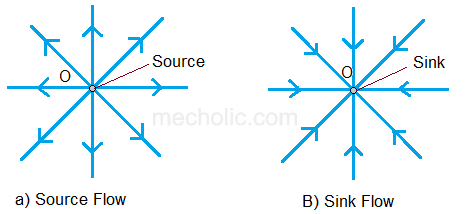What Is the Difference between Source Flow and Sink Flow?
What is source flow?
Source flow is defined as the two-dimensional flow coming from a point called source and moving out radially on a plane in a uniform rate. Fig.a represents a source flow. Here point O is the source. From source, fluid is flowing radially in all direction of plane. The strength of the source, q is defined as the volume flow rate per unit depth of fluid. The unit of source strength is m2/s.Relationship between radial velocity and strength of source
Let q= strength of sourcer = radius from the source O
ur = radial velocity of fluid at radius r
The equation of radial velocity ur at radius r is given by
ur = q/2πr
Above equation shows that the radial velocity of fluid varying inversely as radius increases. For a high value of r, ie at large distance, the radial velocity will be equal to zero.
What is sink flow?
Sink flow is literally opposite to the source flow. In sink flow, fluid moves radially inward (or absorbs fluid) towards a point known as sink, and fluid disappear at sink at a constant rate. Fig.b shows a sink flow, the point O is known as sink. The equation of radial velocity in sink flow is similar but with a sign change to q.The equation of radial velocity ur at radius r is given by
ur = -q/2πr
👉 In source flow and sink flow, there is no tangential velocity.
Read: Free And Forced Vortex Flow


